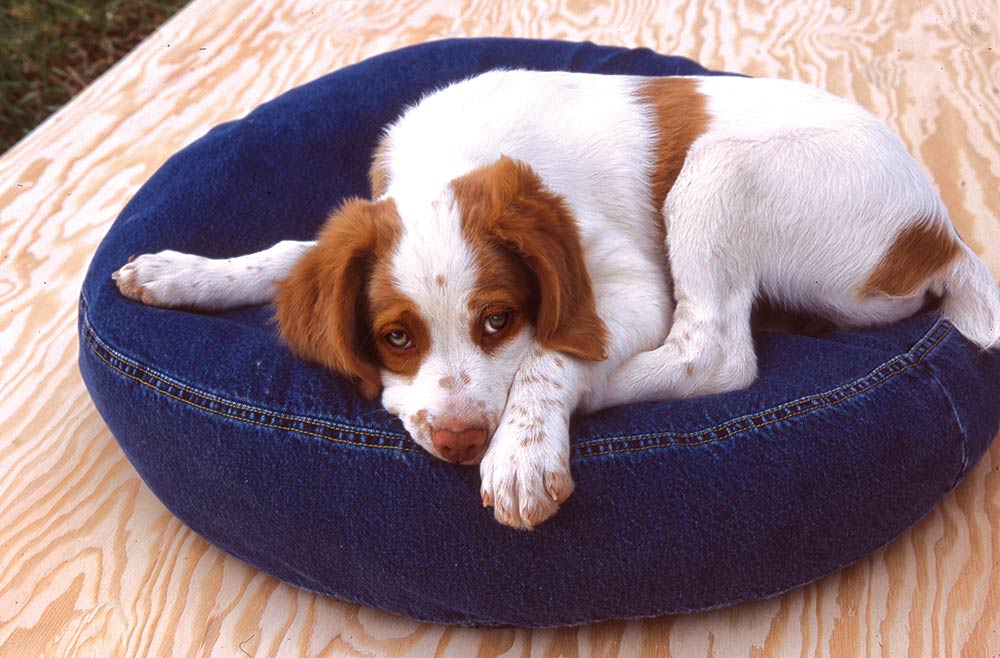Hunting Miss Daisy

One October, near sundown, I was driving Miss Daisy—a Brittany curled up next to me in the front passenger seat. She was totally exhausted and deserved being in the cab.
From the start, the hunt had been excellent, so I kenneled the four older canines in their pickup truck compartments early to give the younger dogs more field time. By noon, Miss Daisy, another Brittany, and a brace of pointers were making long casts, covering the Hungarian partridge hangouts in the big, open rolling prairie. For hours, the foursome never slowed down, each locating their share of the Hun coveys that afternoon. But it was Miss Daisy that got my attention.
Many years ago, I bought a couple of pups from a breeder and friend. He said he had a nice female that he would send. He also mentioned another female pup out of the same litter that was very shy. He explained that when she was less than a month old, something harmful happened to her, and she became very frightened.
Both pups were beautiful, but the small one, as he had warned, was extremely shy. I called her Daisy because she looked like a little flower. She was a cute, little two-month-old Brittany when I got her. She came from wonderful bloodlines, and I was determined to make a bird dog out of her. I kept Daisy with her littermate until she became accustomed to her new surroundings, but she still refused to come out and play with the other dogs. Twice a day I would open the gate to Daisy’s kennel run. Her littermate and the rest of the dogs would go out and run around in the large exercise area. The kennels are connected to the exercise yard, and the whole area is visible from the kennel runs. But I never saw any movement from Daisy.
She always came out and ate at my feet during mealtime.
I would pat and sweet-talk her, but when she finished, she only wanted to be in her kennel box. For several more days, I continued to open the gate to the kennel run when exercising the other dogs. I’d call her by name, though only once. She would poke her head out of the kennel but would go no farther. Each time, I would walk away with the other dogs and ignore her.
About two weeks passed before she came out into the kennel run, but again no farther. It seemed that she found the chain-link fence of the kennel run to be protection from the outside world. Still, I ignored her. This went on for two or three more weeks, until one day she ran out and joined the other dogs for a moment before heading back into the kennel. Each day she would come out and stay a little longer. I kept quiet, never saying a word. It seemed like forever, but she finally stayed with the other dogs for the full exercise period.
Several times a week I’d take the dogs for a short run in my grassland field. It’s about 12 acres, and the perimeter is fenced in barbed wire, roughly a half mile around. The dogs are not allowed to cross the fence, although they are free to explore the whole field. There is a gate between the exercise yard and the big field. When I take the dogs for their run, I just open the gate, and they come streaming out, going full-tilt into the field.
The next hurdle was getting Daisy out into the big field. It took over four months before she made the full circuit of the perimeter with the other dogs and me.
I often took her for rides in the pickup, and as long as she was in the vehicle, Daisy was fine. She loved being with me. After a year, I decided it was time to let her go with the other dogs to look for wild birds. There was no need to take any gun along, as she wasn’t ready for a loud noise. She was doing great until we came to a four-strand, barbed-wire fence, and she refused to cross it. I ignored her, crossed the fence, and walked parallel on the other side. Daisy did not cross for at least 30 minutes. When she did, she seemed to be one happy dog. I believe that was the day she finally broke that invisible barrier. Looking back through my hunting journals, I can still visualize many days driving Miss Daisy with her head on my lap in the front passenger seat. She was my sweet, little hard-hunting wildflower.
Ben O.Williams is a photographer, conservationist, dog breeder, and author of Huns and Hun Hunting, Best Day Yet, and more.
Originally published in Volume 7, Number 6 (Oct-Nov 2019) of Covey Rise.
WANT TO RECEIVE STORIES LIKE THIS FIRST?
SHARE ON
You may also like
The role corn plays for gamebirds and economies ac...
Sportsmen’s conservation policy issues from publ...
Sportsmen’s conservation policy issues from publ...


























